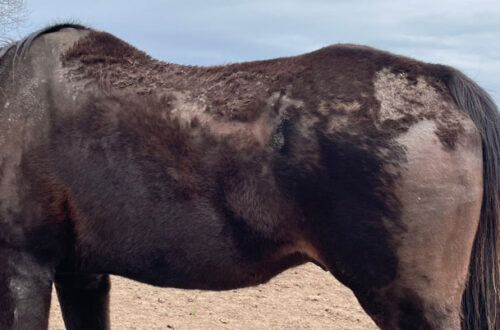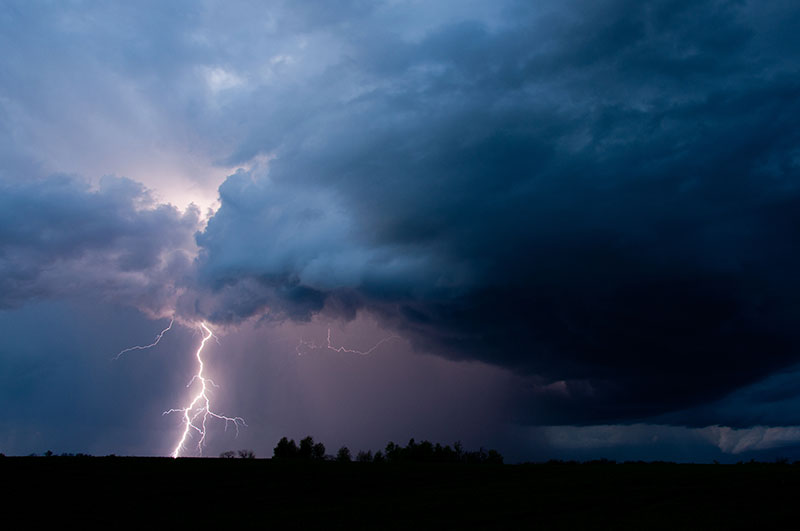
Guidelines for Delay, Cancellation, or Disruption of Events Due to Severe Weather or Natural Disaster
By the USPC Safety Committee
Be Aware—Be Prepared—Get Organized
The United States Pony Clubs (USPC or Pony Club) does not have a specific set of guidelines for cancellation or delay of events/activities due to all of the different geographic areas and potential weather issues across the country. Therefore, it is recommended that the regional and local organizers are in the best position to make decisions regarding the cancellation or delay of events/activities.
Above all, USPC expects its leaders, organizers, and members to follow local and state government guidelines in the event specific or pending inclement weather, natural disaster, or accident is forecast or occurs during an event/activity. The safety of our members, volunteers, and mounts is of utmost importance, therefore in the absence of government direction or guidelines, the Safety Committee would like to take this opportunity to present these tips and resources to aid in determining what steps to take.
Before Events/Meetings:
- Be aware of:
- Potential weather or natural disasters that occur in your area.
- Possible conditions that may influence transportation.
- Outside meetings in teh summer or winter require awareness of the potential for heat- or cold-related illness. Don’t be afraid to cancel a meeting or event if the weather conditions are worrisome.
- Check the weather forecast.
- Check the batteries on your weather radio.
- Communicate and post a copy of the severe weather plan at the beginning of the event/meeting.
- Be prepared to act when weather hits during events/meetings.
During Events/Meetings:
- Follow your severe weather plan.
- Communicate to all participants about the progress of weather and what the severe weather plan calls for next.
- Do not call the “all clear” until the weather has completely passed your area.
After Events/Meetings When the Severe Weather Plan Was Used:
- Evaluate effectiveness and revise the plan.
Guidelines for Extreme Heat:
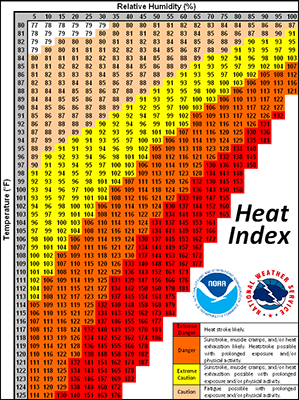
- See the National Weather Service Heat Index Chart (right) or use the Heat Index Calculator, which can be found here.
- If the Heat Index is in the peach zone, proceed with caution.
- If the Heat Index is in the yellow zone, proceed with extreme caution and consider canceling or delaying the event/meeting until a cooler part of the day.
- If the Heat Index is in the orange or red zones, it is recommended that the event/meeting be canceled or delayed until a cooler part of the day.
- The National Institute for Occupational Safety and Health (NIOSH) also provides a Heat Safety Tool App, which can be found here.
- If a person or an equine is acclimated to rising heat and humidity as they have conditioned for an activity, they can tolerate a higher heat index than a shaggy pony who is seeing the first hot day of spring. We should be ready to reduce the expectations of exertion and competition when the conditions we encounter are extreme for our mounts and participants.
- Some signs of horses in distress in heat include profuse sweating (or not sweating, a serious condition called anhidrosis), body temperature over 102 degrees Fahrenheit, elevated pulse and respiration, panting (fast, shallow respirations), and stumbling. Any of these are reasons to give emergency aid to the mount.
The following Air Temperature chart can be used as a guideline for working with our equine partners:
If Air Temp °F + % Relative Humidity =
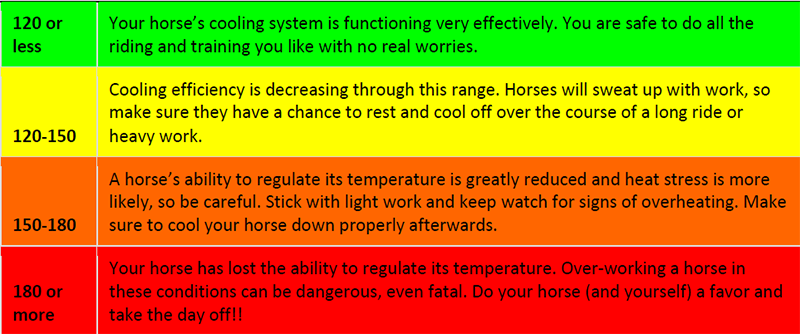
Guidelines for Extreme Cold:
- See the National Weather Service Wind Chill Chart below.
- If the Wind Chill Temperature Index is in the light blue zone, proceed with caution and limit exposure to the elements.
- If the Wind Chill Temperature Index is in the medium blue, dark blue, or purple zone, it is recommended that the event/meeting is canceled or delayed until a warmer part of the day.
- Studies have shown that horses’ lungs can be damaged during strenuous exercise in cold temperatures.
- There is clear research supporting when equine respiratory tissue is damaged by cold temperatures. We have to make the determination that turbulent air (the act of breathing hard) at 15 degrees Fahrenheit causes damage to the lining of the airways from the nostrils to air-exchanging alveoli deep in the lungs. Fifteen degrees is uncomfortable for people too, so it is recommended to drop exercise to a walk or not ride at 15 degrees or lower.
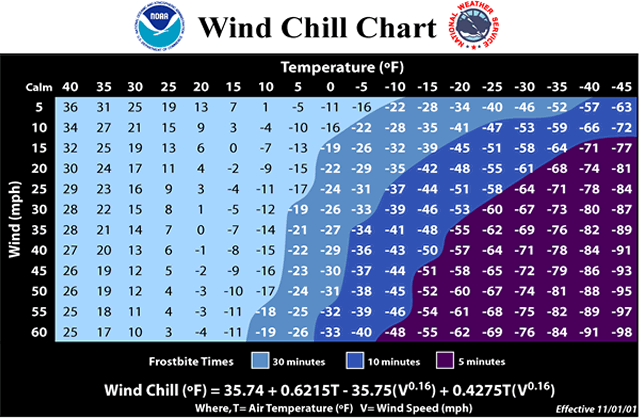
Guidelines for Poor Air Quality:
- See the United States Environmental Protection Agency Air Quality Index (AQI) below.
- If the AQI is in the yellow or orange zone, inform participants that those with a sensitivity may be at risk, and those in charge should make accommodations for those who identify that they have a sensitivity. Proceed with caution and consider limiting the level and duration of exercise.
- If the AQI is in the red zone, proceed with extreme caution, and reduce the level and duration of exercise.
- If the AQI is in the purple or maroon zone, it is recommended that the event/meeting be canceled or delayed until a time of day with improved AQI.
- Air quality is another stress on our horses, just as it is on people. Horses respond to irritants and particulates in their airways by coating the breathing surfaces with mucus. The downside of the protective mucus production is if the irritation continues, the horse’s body makes more mucus-producing cells and can respond faster and with more mucus every time an irritating situation occurs. Once they make more cells, they never lose them. This is the mechanism of heaves (Recurrent Airway Obstruction, sometimes called Equine Asthma). This physiologic response of the horse is why we need to protect them from smoke, smog, dust, pollen, mold, fungi, and even cold. When air quality is poor for humans, take precautions for your equine partners as best you can.
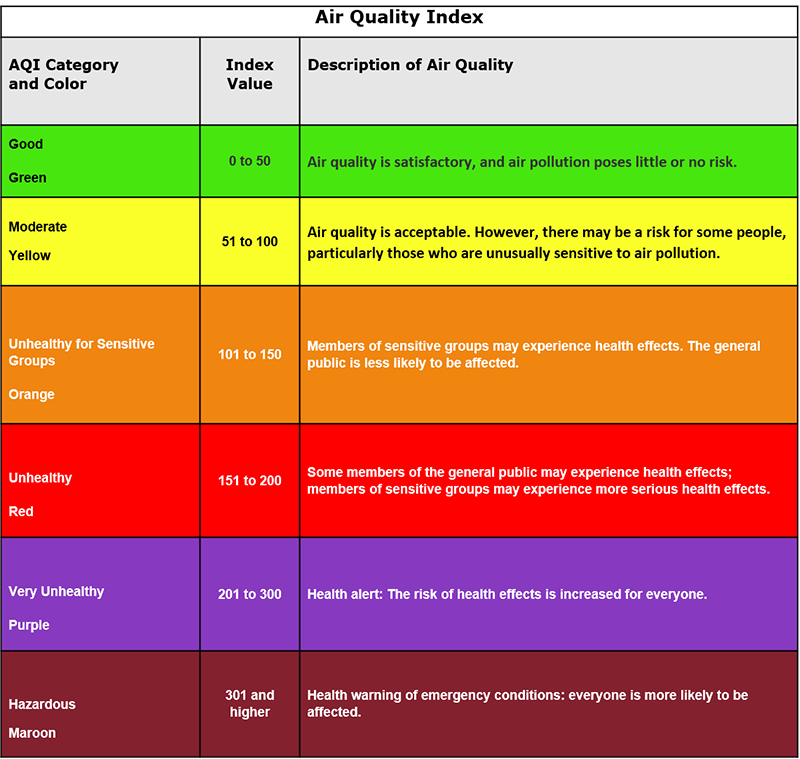
Resources:
- Federal Emergency Management Agency (FEMA)
- Department of Homeland Security
- American Red Cross
- Your State Department of Transportation
- United States Environmental Protection Agency
- National Weather Service
- National Institute for Occupational Safety and Health
- USPC Rally Organizers Resources
- USPC Rulebooks- Uniform Officiation Rules
- USPC Safety Handbook
- USPC C Level Manual pages 237-239





